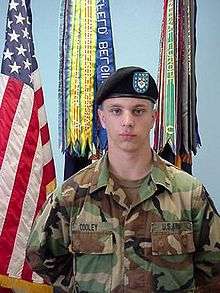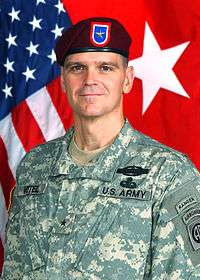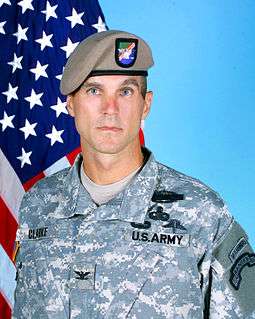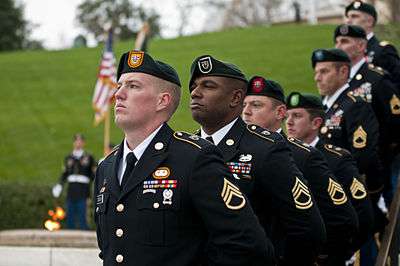Berets of the United States Army
Since June 14, 2001, the black beret is worn by all United States Army troops unless the soldier is approved to wear a different distinctive beret. In the U.S. Army there are three approved distinctive berets: Maroon, tan, and green.
On June 13, 2011, the Army announced that the patrol cap will replace the black wool beret as the default headgear for the Army Combat Uniform.[1]
The maroon beret has been adopted as official headdress by the Airborne forces as a symbol of their unique capabilities, the tan beret by the 75th Ranger Regiment, and the green beret by the Special Forces.
History
In the United States military, the beret was unofficially worn by a variety of special operations units during and following World War II. In the spring of 1951, the 10th and 11th Ranger Companies wore black berets during their training at Camp Carson, Colorado, before their deployment to Japan.
In the post-Vietnam era, morale in the U.S. Army waned. In response, from 1973 through 1979 Headquarters, Department of the Army (HQDA), permitted local commanders to encourage morale-enhancing uniform distinctions. Consequently, many units embraced various color berets, for example armor and armored cavalry units often adopted the black beret. Similarly, many other units embraced various colored berets in an attempt to improve dwindling morale. In particular, the First Cavalry Division assigned various colored berets to its three-pronged TRICAP approach. In this implementation, armored cavalry, airmobile infantry units, air cavalry units, division artillery units, and division support units all wore different colored berets, including black, light blue, kelly green, and red.
Black

A black beret was authorized for wear by female soldiers in 1975, and is used also for mechanized units, troops, and guards. The black beret is worn by soldiers in the United Army.[2]
On January 30, 1975, it was officially allowed to be worn by the newly created battalions of United States Army Rangers who had worn it unofficially during the Vietnam War. In 1979 the Army chief of staff ruled that the black beret was restricted to just Ranger and Airborne units (the latter receiving their distinctive maroon berets on November 28, 1980).
In 2001, the black beret became the primary headgear for both the service uniform (in garrison setting) and dress uniform for all United States Army troops unless the soldier is approved to wear a different distinctive beret. In 2011, the Army changed back to the patrol cap for wear with the utility uniform, with the beret remaining the headgear for the dress uniform.[3]
Maroon

In 1943 General Frederick Browning, commander of the British First Airborne Corps, granted a battalion of the U.S. Army's 509th Parachute Infantry Regiment honorary membership in the British Parachute Regiment and authorized them to wear British-style maroon berets. During the Vietnam War, U.S. military advisers to Vietnamese airborne units often wore the Vietnamese French-style red beret.
HQDA policy from 1973 through 1979 permitted local commanders to encourage morale-enhancing distinctions. Airborne forces chose to wear the maroon beret as a mark of distinction. This permission was rescinded in 1979 when the army introduced a policy of standardized headgear and designated wear of the black beret for Ranger and Airborne units. On 28 November 1980, permission was given for airborne organizations to resume wearing the maroon beret.
Tan

On 14 June 2001, U.S. Army Rangers assigned to the 75th Ranger Regiment were authorized to wear a distinctive tan beret to replace the black berets that had recently become the army-wide standard. The tan beret is an homage to the buckskin caps worn by Rogers' Rangers during the French and Indian War (1755–63).
Green

In the U.S. armed forces, the green beret may be worn only by soldiers awarded the Special Forces Tab, signifying they have qualified as Special Forces soldiers.
U.S. Army Special Forces wear the green beret because of their link to the British Commandos of World War II. The first Ranger unit, commonly known as Darby's Rangers, was formed in Northern Ireland during the summer of 1942. On completion of training at the Commando Training Depot at Achnacarry Castle in Scotland, those Rangers had the right to wear the British Commando green beret, but it was not part of the regulation uniform at the time and was disallowed by the U.S. Army. [4]
The 10th Special Forces Group (Airborne) had many veterans of World War II and Korea in its ranks when it was formed in 1952. Members of the 10th SFG began to unofficially wear a variety of berets while training, some favoring the red or maroon airborne beret, the black beret, or the green commando beret. In 1953, a beret whose design was based on that of the Canadian Army pattern, and which was rifle-green in color, was chosen for wear by Special Forces units.
Their new headgear was first worn at a retirement parade at Fort Bragg on 12 June 1955 for Lt. Gen. Joseph P. Cleland, the now-former commander of the XVIII Airborne Corps. Onlookers thought that the commandos were a foreign delegation from NATO.
In 1956 Gen. Paul D. Adams, the post commander at Fort Bragg, North Carolina, banned its wear, even though it was worn on the sly when units were in the field or deployed overseas. This was reversed on 25 September 1961 by Department of the Army Message 578636, which designated the green beret as the exclusive headgear of the Army Special Forces.
When visiting the Special Forces at Fort Bragg on 12 October 1961, President John F. Kennedy asked Brig. Gen. William P. Yarborough to make sure that the men under his command wore green berets for the visit. Later that day, Kennedy sent a memorandum that included the line: "I am sure that the green beret will be a mark of distinction in the trying times ahead." By America's entry into the Vietnam War, the green beret had become a symbol of excellence throughout the U.S. Army. On 11 April 1962 in a White House memorandum to the United States Army, President Kennedy reiterated his view: "The green beret is a symbol of excellence, a badge of courage, a mark of distinction in the fight for freedom." Previously, both Yarborough and Edson Raff had petitioned the Pentagon to allow wearing of the green beret, to no avail.
References
- ↑ "ACU changes make Velcro optional, patrol cap default headgear". U.S. Army http://www.army.mil. Retrieved 13 June 2011. External link in
|publisher=(help) - ↑ p.223 Stanton, Shelby U.S. Army Uniforms of the Cold War 1948-1973 1994 Stackpole Books
- ↑ "Army dumps beret as official ACU headgear".
- ↑ Army Black Beret: A Short History of the Use of Berets in the U.S. Army